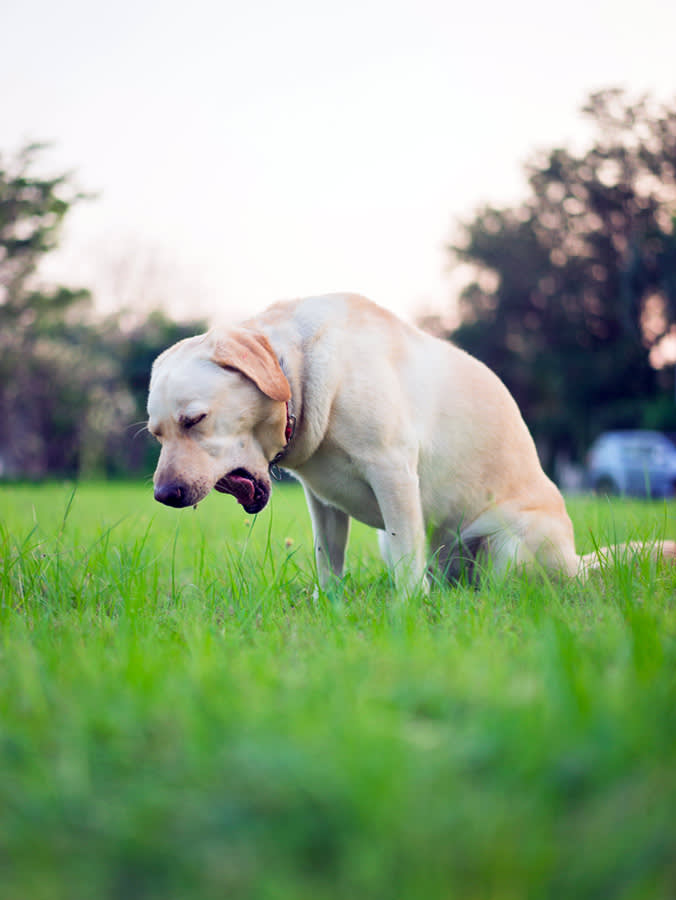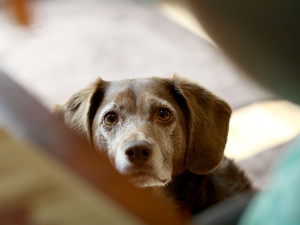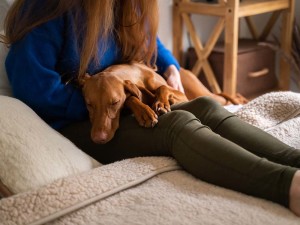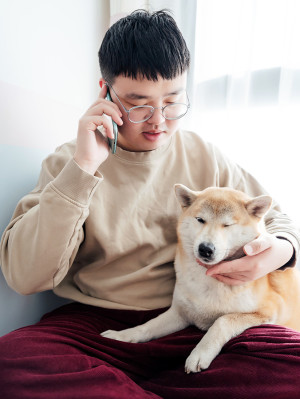What to Do If Your Dog Eats Something They Shouldn’t
Whether it’s socks, stones or an affair partner’s underpants (true story), a vet weighs in on how what to do when your dog swallows something that wasn’t on the menu

Share Article
If you have a dog, you can probably relate to the following scenario: you see them eating something they shouldn’t be from across the room and your eyes meet in a Western-style standoff. You freeze; one false move and you’ll be sifting through poo to find the offending item for days… if you’re lucky.
Perhaps the event is less dramatic: the chicken carcass mysteriously disappears off the kitchen counter and, after careful consideration of the line-up, your dog is identified as the prime suspect. Sometimes, the first you know of your dog eating something they shouldn’t is when you step in a pile of vomit containing shreds of your favourite jumper. If you’ve ever found yourself in any of these situations, you are not alone. The fact of the matter is that dogs like to eat things they shouldn’t, the less edible the better.

Get (totally free) deals for food, treats, accessories, tech and way more pet parenting must-haves.
opens in a new tabThe fiasco becomes even more awkward when multiple pets are involved. Four Labradors and a Yorkshire Terrier were brought into my veterinary surgery after a Christmas cake was reduced to crumbs when the owner left the room. Unsurprisingly, the four Labradors brought up an equal share of cake and raisinsopens in a new tab but the Yorkshire Terrier surprised us all by vomiting up no cake but three socks.
Side note: cat parents shouldn’t think their kitty is entirely innocent in this area. Whilst string and tinsel tends to be their perilous pleasure of choice, I have known of at least one cat eat a stone that had to be removed surgically.
So, as a responsible pet parent, what should you do when you think your doggy has had their way with a non-consumable item?
Our pets lead secret lives, they aren’t with us every second of the day. Even if we think their movements are well controlled, their cunning and motivation know no bounds when it comes to snaffling things they shouldn’t. Objects can sit in the stomach for months before moving through into the intestine and causing a problem. No matter how unlikely, if your pooch is unwell, you should never disregard the possibility that they have eaten something they shouldn’t. However, make sure to search everywhere before you make any rash decisions. I have made it to surgery before, and then received the phone call to say that the missing battery was found beneath the couch.
What things do dogs commonly eat?
There are no limits to what some dogs will eat but the following items commonly feature on the surgery list.
Bones
These crunchy snacks are highly desired by dogs. They are often fed intentionally as part of a raw diet or as a treat. On other occasions they are resourcefully sourced by the dog themselves from bins and animal carcasses. Whilst bones can form part of a healthy diet, they can also carry a substantial risk. Cooked bones often splinter, resulting in sharp ends that can puncture the gastrointestinal tract whereas large bones, swallowed whole are very likely to become lodged.
Kebab sticks and corn on the cob
Dogs love barbecues. Their humans are distracted and there is food everywhere. I have known kebab sticks puncture through not only the intestine but right through to the outside. Corn on the cobs tend to be swallowed whole causing an obstruction with a very characteristic pattern at X-ray.
Stones
I see nothing appetising about a stone but dogs beg to differ. They love to play with them, carry them and all too often swallow them. I have had many dogs in for X-rays following trauma and found them to be walking around with a rockery in their stomach. It’s not until the stone begins its passage through the intestine that it causes a problem.
Toys (human and dog)
Toys are not all fun and games; unsupervised toys are often destroyed and eaten whether they belong to the dog, cat, child or adult.
Clothing
Clothing carries human scent and for this reason, dogs love to steal it and sometimes even swallow it. Clothing presents a serious issue as it tends to partly lodge in the stomach with a strand moving down into the intestine. The intestine tries to squeeze it along but, because of the piece stuck in the stomach, the intestine ends up bunching over the fabric in a concertina. The cloth forms a tight band that eventually saws straight through the intestine. Aside from the obvious detriment to your pet’s health, these objects can cause other issues. At my surgery, we once discovered some underwear during intestinal surgery and returned the item to the owner in a sandwich bag. The colour drained from the man’s face and a blazing row broke out in the consult room as the woman demanded to know whose lingerie she was now holding.
Bedding
Bedding is not only exceptionally comfortable but also in easy reach whenever your dog wakes and fancies a chew. A dog that’s eaten some bedding can lead to a situation that is messy, expensive and dangerous.
Why do dogs eat things they shouldn’t?
Animals will eat things they shouldn’t for several reasons. The item may be tasty or carrying a human scent. The animal may be bored or anxious, enthusiastic in their playtime or they may simply be guarding their favourite resource. After all, the best way to prevent anyone else from having something is to swallow it as quickly as possible, the less chewing the better.
Younger dogs are more prone to this behaviour as they are naturally more inquisitive and playful. Certain breeds are prone to oral compulsive disorders. Belgian Malinois like to have something in their mouth and the higher their arousal goes the more likely they are to chew the item up and swallow it. Labradors will eat anything they can get hold of. The one-year-old Labrador who arrives with a history of vomiting is considered to have eaten a foreign body until proven otherwise.
Underlying disease can cause an animal to constantly eat things they shouldn’t, this is known as ‘pica’ and can drive your pet to obsessively eat items that aren’t edible. I have known an older dog eat several tin cans whole along with a variety of other metal objects, causing significant damage to its throat and stomach. It was later diagnosed with canceropens in a new tab.
What are the symptoms of an obstruction?
There are lots of signs that your dog has ingested something they shouldn’t have. These include:
persistent vomitingopens in a new tab
passing diarrhoeaopens in a new tab or not pooing at all
not eating
belly pain
restlessness
lethargy
When should you go to the vet?
Lots of things will cause vomiting in our dogs. Many of them will resolve within 24–48 hours with a bland diet fed little and often. If your pet’s vomiting is becoming more frequent during this time frame, they are refusing food and seem lethargic or in pain then it is worth getting them checked by a professional. If you have seen your pet eat something they shouldn't have, always phone your vet for advice as each individual situation will call for a different approach.
What will your vet do if your dog has eaten something they shouldn’t?
If an item has just been eaten it is sometimes possible to retrieve it by making them sick with an injection. This isn’t possible in every scenario as some items will cause more damage on their way back up. If inducing vomiting isn't an option, your vet is likely to recommend either monitoring to see how it passes through, an endoscopy to attempt to grab the item (like the claw machine in the arcade) or surgery to open the stomach and retrieve the item before it gets stuck or pokes through something it shouldn’t.
Deciding on the best course of action will be made easier with diagnostics such as blood work and imaging. It can be difficult to diagnose a foreign body, especially if nobody witnessed the ingestion. Sometimes several ultrasounds and X-rays over the course of multiple days can be required, especially in the case of a partial foreign body which isn’t blocking the intestine completely, or a linear foreign body caused by cloth or string. In subtle cases, surgery can be used as a diagnostic tool and it can be safer to go in and rule out an obstruction than waiting for one to cause a problem.
As time passes, the object will move through into the intestine where it is more likely to get lodged or perforate. This leads to peritonitis and septic shock. At this point your pet is going to be critically ill and will require a long stay in hospital to attempt to stabilise them prior to surgery. The surgery may involve several incisions into the gut or even the removal of entire segments of the intestine.
The chance of your pet surviving depends on how quickly the problem is addressed and how much damage the object has caused; early intervention is always better.
How much will treatment cost?
An initial consult to check your dog over is going to vary from £40–300, depending on the time of day and whereabouts in the country you live. Making your pet sick in an attempt to retrieve the item usually costs between £200–500. An endoscopy or simple surgery in an otherwise well dog to remove something from the stomach will be around £1,500–2,500.
Diagnostics and intestinal surgery is around £2,500–3,500 and the intensive care of a septic patient as well as surgery can easily exceed £5,000 with no guarantee of a good outcome.
Consider this your sign to get pet insuranceopens in a new tab sorted (if you haven’t already).
How can I prevent my dog from eating something they shouldn’t?
Your dog might be a stealthy sock snaffler or a serial bin diver but there are steps you can take to prevent your vet from knowing you by name.
Always buy toys and chews appropriate for your pet’s size and jaw strength. As soon as they start to damage an item it should be confiscated. I have a high shelf full of armless, headless soft toys that my dogs stare at all day. I should probably throw them away. Your pet should never be left unsupervised with bones, chews or toys.
To combat boredom, leave your pup with a block of ice filled with safe fruit and veg (such as peas, strawberries and apples). As it melts it becomes a healthy snack dispenser and is fun to chase around the kitchen. If this amount of mess fills you with dread, then consider a Kong-type toyopens in a new tab (of appropriate strength so they can’t destroy it) stuffed with something tasty, safe and edible like peanut butter. Freezing this makes it last even longer.
Avoid leaving swallowable-sized objects in easy reach of your pet and place them in a pen or crate when they are unsupervised so they have no access to things they can destroy. Chew-proof beds are a brilliant investment to keep your destructive dog comfortable.
There is plenty to pick up and swallow in the outside world so pay attention and keep them in sight and out of bushes. To do this you’ll need no distractions and a good recallopens in a new tab or a short lead. Have a pocket full of high-value treatsopens in a new tab to trade for any object they might find. If they have a serious problem consider placing a muzzleopens in a new tab on them.
Despite our best efforts, pets have a mind of their own and will outsmart us frequently. Rapid veterinary advice and intervention will prevent the problem from escalating. Given the outlined costs, consider having savings or insurance that will allow you to make decisions without worrying about the financial implications.

Dr Nina Blackmore, MRCVS, BVSc, PgCertSAECC
Nina Blackmore is a vet who, after leaving the Royal Army Veterinary Corps, took up two very different lives. For four long, chaotic days each fortnight she lives in a tiny house next to a small animal veterinary hospital in Boston, managing hospitalised patients and treating any emergency cases that turn up. As well as emergencies she also has a keen interest in pain management and acupuncture. The rest of her time is spent in a quirky bungalow in Rutland where she and her husband run a self sufficient small holding and a dog home boarding business. She spends her life surrounded by animals and has made it her life goal to help as many as possible.


